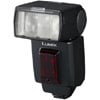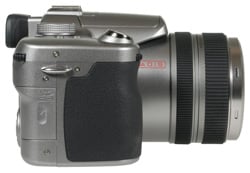Panasonic Lumix DMC-FZ50
-
-
Written by Gordon Laing
Panasonic Lumix DMC FZ50 design and controls

 |
The Panasonic FZ50 is designed to look and feel like an SLR camera, although like other all-in-one super-zooms, it lacks the ability to swap lenses. Measuring 141x86x142mm, it’s slightly wider but also slightly shorter than Canon’s EOS 400D / Rebel XTi digital SLR. This additional width has allowed Panasonic to implement a generous, deep grip with plenty of room between your right finger tips and the lens barrel.
The FZ50’s available in silver or black and we’ve pictured the former alongside Canon’s entry-level DSLR above and below where it’s clear how much more the Panasonic has to hold onto. It’s also important to consider the fact the FZ50’s body houses a 12x optical zoom, yet measures roughly the same size as a compact DSLR with a 3x zoom. The FZ50’s simply very compact for its capabilities.
The FZ50 shares essentially the same body design and control layout as its predecessor the FZ30, with a few minor tweaks we’ll mention as we go along. The build quality is very good and feels to a higher standard than many all-in-ones. It’s certainly very comfortable to hold and use.
The bulk of the FZ50’s controls are located on its upper right surface and to the right of the screen at the back. The upper surface houses a small power switch, buttons to select the Optical Image Stabilisation and continuous shooting modes, along with the main mode dial.
The mode dial offers the usual Automatic, Program, Manual, Shutter and Aperture Priority modes along with selecting playback, movie mode, the Scene presets and a Custom option; the latter replaces the second Scene position on the earlier FZ30’s dial and allows a wide range of user customisation.
A finger wheel on the front of the body and a thumb wheel on the back are used to scroll through various functions and also allow independent control of the aperture and shutter in full Manual mode.
Like the FZ30, four buttons still run down the right side of the screen, although the Menu button has been swapped for one labelled Function. Pressing this while shooting brings up a context-sensitive menu offering direct access to metering, AF, White Balance, ISO, resolution and compression settings; it’s wonderful to now enjoy direct access over these controls without delving into menus, and it’s a great improvement over the FZ30 – for a demonstration of this, see our video tour.
 |
Of course this means the old Menu button needs a new home, and in line with Panasonic’s latest compacts, it’s been relocated to the middle of the four joypad style buttons towards the bottom right of the back of the camera. These four buttons allow you to open the self-timer, exposure compensation and flash options, along with reviewing the last image taken.
There’s a pop-up flash above the lens and new to the FZ50, a TTL hotshoe for external flashguns. With the popup flash opened, you can select Auto with or without redeye reduction, forced flash or slow synchro, again with or without redeye reduction. There’s also flash compensation available from -2EV to +2EV.
Battery
and connectivity
The camera’s powered by the same compact 710mAh Lithium-Ion battery as the FZ30 and supplied with a recharger. Panasonic claims each charge should be good for 360 shots under CIPA standards, which is comfortably over the 280 shots of the FZ30. The extension in life is attributed to the more efficient Venus III engine, and certainly during our tests a single charge was generally good for over 300 images under a variety of conditions.




